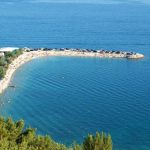The young architects who have designed the new Žnjan have big plans for Split’s forgotten areas, including Duilovo.
The architectural competition for the areas of Žnjan, Duilovo and Trstenik bay highlighted that there is a younger generation of architects interested in urban planning – and it was budding architects Ivan Jurić, Mirjana Radoš, Marin Kaliterna and Luka Mužinić to walk away with the winning design.
This talented group of designers have expressed that they are also interested in uniting their creative forces for the outer parts of Split that have been subject to dispute for years with projects that failed to come to fruition. These areas include Lora, the northern part of the peninsula, the area from Zenta to Stobreč, and the eastern part of Split. Slobodna Dalmacija spoke with Jurić, Radoš and Mužinić to find out more on February 23, 2018.
Ivan Jurić had outstanding results at architectural competitions over the years, and even won as a student for his design for the West Coast Riva in Split, and took one of three equal awards for the East Coast. But no such project ever materialized, which is something Jurić hopes will be different this time as his power is taken more seriously than in previous years.
“I’m most interested in the jury, and in this case, DAS has been included, and it seems to me that any suspicious urban practices that come light will be corrected,” says Jurić.
“Hoping for a better tomorrow, we have set aside, but we have not forgotten some of the negative experiences from the past that we’ve seen in competitions,” adds Luka Mužinić.
You have suggested the reforestation of the coast from Trstenik to Duilovo to create an urban forest. Which vegetation would prevail?
“We counseled a colleague who graduated with a degree in Agriculture, and she advised us about all of the plants concerning the location exposed to the wind and sea. They are mostly Mediterranean plants. The main two pines are located along the northern part of the promenade and define the edge of the forests, and the south palms are not subject to this disease that is currently attacking palm trees. The palms direct pedestrian paths, the facade forms the pines and vegetation changes inside. Overgrowing carob trees, almond trees, juniper trees and the like, are painted in color to give different environments throughout the year,” explains Mirjana Radoš.
The jury recommends that you should plan for more parking places in your design, but you claim that there are enough if Duilovo’s space is taken into account. How did you solve the contact zones?
“Duilovo is now a tourist zone. We have lowered the bottom plateau to the public, and in the upper part, we have concentrated the tourist area in areas where some projects are already underway and have proposed the rest turn into the M3 zone which allows the balance between residential and tourist purposes. An important part of the proposal is a tunnel linking the area from City Center to a marina that would no longer be at Duilovo but moved below the Hotel Zagreb,” says Jurić.
“For Trstenik bay, we have accepted the planned tourist projects, and the rest is planned as the M3 zone where health tourism and residential facilities are possible. Our solution is concentrated around the pedestrian areas we have organized, and the rest will be replenished as investors, that is, the City sees it,” notes Jurić.
What would change at the general urban planning level (GUP)?
“Here we have emphasized that the southern front is a huge capital city and a pledge for the future. But we can also talk about the northern façade and the new entry into the city. There is room left to react to this void that is unused in the north. I’m sure that in the future, by changing the mental image of the space we now experience as if it were not, it would become a new ‘neighborhood’ of Split,” Mužinić believes.
How would this happen so that investors can be attracted to an industrial business zone or change the purpose in the GUP?
“First of all, it would be a good area to run a competition to see what people think because you have a large number of young people, architecture students and architects who fend off the desire to react to that space. It should be an international poll to examine what can be done in this area, which is certainly very powerful,” Mužinić believes.
What are some of the outer areas that attract you?
“Areas like Duilovo. We are asking people to understand that this has huge potential and that it will be a city one day. It is a massive area – a space that will inevitably be captured by the city, which people today do not even consider part of the city of Split,” Radoš notes.
You can read about the young architect’s project on Žnjan here.
Excerpts taken from Slobodna Dalmacija









